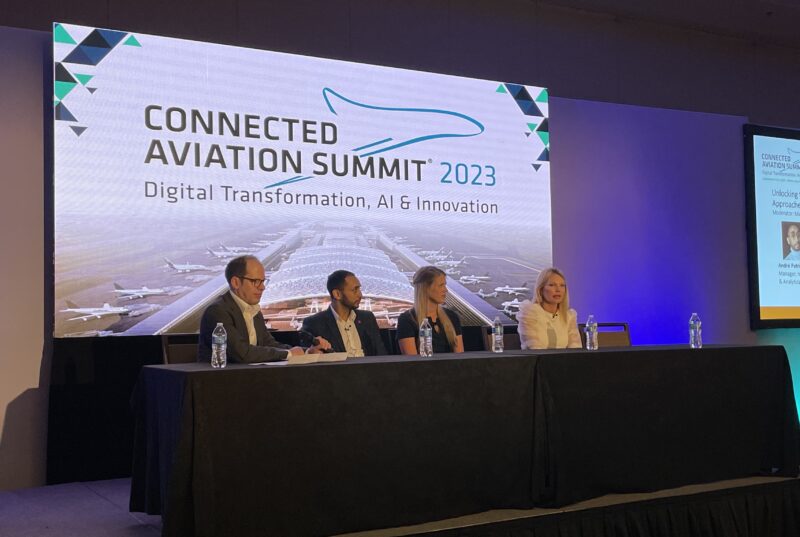[ad_1]

Connected Aviation Summit. From left: Mark Holmes; André Patrick, Air Canada; Brittany McSweeny, Southwest Airlines; Angela Vargo, Breeze Airways. Photo: Access Intelligence
DENVER, COLORADO — Providing passengers in-flight internet connectivity (IFC), with live TV and on-demand entertainment streaming services from takeoff to landing is gaining serious momentum in the airline industry.
Satellite operators like OneWeb, Intelsat, Viasat and Telesat are among the satellite providers competing to offer IFC services to airlines. According to a Frost and Sullivan report released in July, researchers expect that the global in-flight connectivity service market will reach $968.8 million by 2032. Increasing passenger demand for seamless connectivity, advancements in satellite communication technologies, and air traffic growth will drive this expansion, according to the report.
How that connectivity works and how airlines pay for the investment in satellite technology was part of a discussion at the Connected Aviation Intelligence Summit, in Denver, Colorado, on Thursday.
Andre Patrick, manager of In-flight, Wi-Fi and Analytics for Air Canada, said that free Wi-Fi is still a moving target for airlines, and the hospitality industry is driving customer expectations. “When you go to a hotel, you connect for free,” he said. “You don’t have to think about it. I think that mentality is coming to the airlines.”
Air Canada announced this week that it is expanding its connectivity deal with Intelsat, adding 100 aircraft. Air Canada has been working with Intelsat and its predecessor, Gogo, for 14 years connecting for various aircraft of the flagship Canadian air carrier.
Patrick shared an anecdote of a passenger conducting day-trading on a flight that showed the significance of staying connected. “The response I got from the flight crew was that it was a super important deal and he had internet available so he didn’t miss out on that trade,” Patrick said. “We’re talking about an $80,000 trade that was happening. Connectivity is even more important than just sending an email.”
Brittany McSweeny, senior CX Connectivity consultant for Southwest Airlines, said the airline sees customers connect to Teams calls. “They’re listening in and they’re participating via chat,” she said. “Being able to provide a consistent, reliable experience where customers are able to work from the sky is really important to us.”
Last year, Southwest Airlines added Viasat as an in-flight connectivity provider. The airline also recently expanded the audience that receives free internet. “It had just been for our preferred members, which are our top tier loyalty members,” McSweeny said. “Now anybody who purchases certain business class will receive internet as well.”
Angela Vargo, head of Brand Marketing for Breeze Airways, talked about how connectivity is part of the young airline’s strategy to build its brand. Breeze Airways was created by JetBlue founder, now CEO of Breeze, David Neeleman, in May 2021. The company works with Viasat for their IFC solution.
“When you are starting an airline from scratch, you think about everything, all kind of in the same bucket,” she said. “I’m building a brand loyalty program and a Wi-Fi experience all at the same time. So as a result, all of these things are going to be very highly integrated. There is no wall. Because a lot of what airlines have had to do is kind of shoehorn existing technologies into their IFC model.”
Vargo said that Breeze is going to launch a “more enhanced experience” as part of their brand loyalty program next year, but the airline doesn’t offer free Wi-Fi on its flights.
“I am not a believer that 100% of people need to have free Wi-Fi on a flight. I think that there’s so many other methods to store content and do free messaging,” Vargo said.
As the market of satellite solutions evolves, Vargo said she’s interested in Low-Earth Orbit (LEO) satellite solutions like Amazon’s Project Kuiper constellation.
“Having started this journey with Wi-Fi back in the Dark Ages, this is the second really big evolution that we’ve experienced. I think it’s exciting to watch because there will be a new entrants, and they will push the limits. That’s always going to help us innovate along with some of the partners,” she said. “I think it’s pretty interesting to watch how this will play out, especially with new entrants to the market like Amazon.”
[ad_2]
Source link
